Surface-Enhanced Raman Spectroscopy (SERS) Substrates
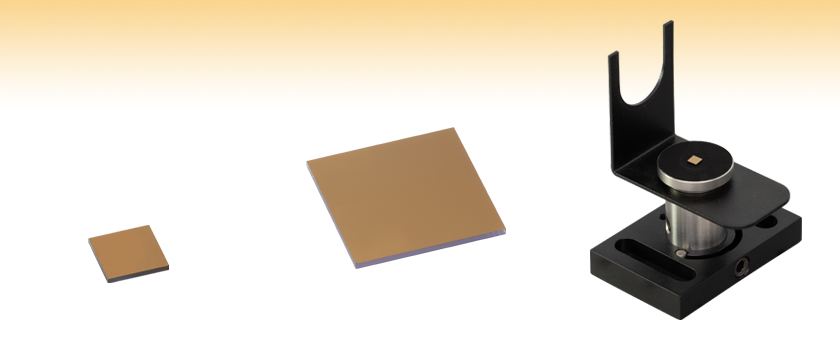
- Gold-Coated Textured Quartz Substrates
- Plasmonic Nanostructures Enhance Raman Scattering Signal
- Parts per Billion Sensitivity
- Optimized for 785 nm Laser Excitation
RCT4M
4.3 mm x 4.3 mm Active Area
Application Idea
The RCT4M Gold-Coated SERS Substrate can be mounted to the RSBR1(/M) sample stage. Please see the Overview tab for more information.
RCT10M
9.5 mm x 9.5 mm Active Area

Please Wait
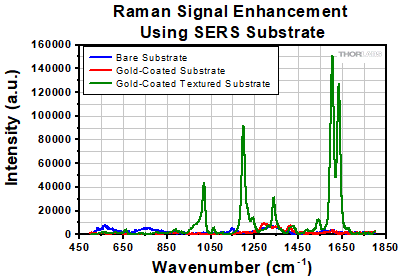 Click to Enlarge
Click to EnlargeFigure 1.1 This graph shows the effects of SERS on the Raman signal of 1 mM 1,2-di(4-pyridyl)ethylene. All samples were prepared using the same immersion method. Data was collected using the RSB1 Raman kit with 785 nm laser excitation and a 5 second integration time. The laser spot size was 1.5 mm2 and the power was set to 10 mW.
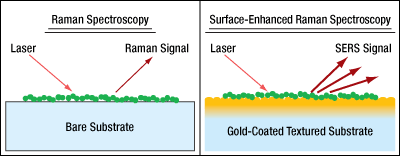 Click to Enlarge
Click to EnlargeFigure 1.2 An illustration to show the difference between Raman spectroscopy and Surface-Enhanced Raman Spectroscopy. In SERS, incident laser light creates an electric field that increases the probability of Raman scattering, thereby enhancing the measured Raman signal.
Got Questions?
Our engineers and expertise are here for you!

Jason Williamson
Director of Business Development
Thorlabs Spectral Works
If you are not sure whether our catalog SERS substrates meet your needs, we invite you to contact us to discuss your specific application, including custom or OEM requirements you may have.
Just press the button, and we'll get back to you within the next business day.
Features
- Gold-Coated Textured Fused Quartz Substrates for Surface-Enhanced Raman Spectroscopy (SERS)
- Plasmonic Nanostructures Enable Parts per Billion Sensitivity*
- Compatible with Thorlabs' Modular Raman Kit and Portable Raman Spectrometer
- Square Substrates with 4.5 mm or 10.0 mm Edge Lengths and >90% Active Area
- Single-Use Substrates with 6 Month Lifetime Outside of Vacuum
- Volume Quantities and/or Custom Sizes Available
Applications
- Detection of Fingerprint Signals from Molecules
- Quantitative Analysis of Chemical Mixtures
- Identification of Illegal or Dangerous Substances
- Quality Inspection (Pharmaceuticals, Food, etc.)
- Monitoring Chemical Processes at Production Sites
Thorlabs' Surface-Enhanced Raman Spectroscopy (SERS) Substrates are designed for SERS, a subset of Raman spectroscopy that can enhance the Raman scattering of a sample by orders of magnitude. Each SERS substrate is made from a textured fused quartz substrate with gold deposited on the surface, creating plasmonic nanostructures that enable sensitivity down to parts per billion.* More than 90% of each chip's top surface is SERS active.
Raman scattering is a rather rare event and occurs for only about 1 in 1 million exciting photons. Therefore, it is typically necessary to excite the sample with a high-power light source. SERS is a technique that can enhance the Raman scattering of a sample by using a metal surface as a sample substrate. There are two primary mechanisms that cause this enhancement. The first is an electric field enhancement, which is created by the excitation of localized surface plasmons. When molecules under interrogation are within the presence of this electric field, the probability of Raman scattering increases greatly. The second mechanism is a chemical enhancement due to inter- and intra- molecular charge transfer between the metal and molecule of interest. This makes SERS a non-destructive, highly sensitive technique that can be used to measure extremely low sample concentrations with significantly lower incident laser power in comparison to a standard Raman measurement. For further details on using SERS substrates for commercial applications, please see the Webinar tab.
Usage, Handling, and Care
Samples can be prepared on the SERS substrates using a drop-cast method. Simply place 2 to 10 µl of aqueous solution onto the gold side of the substrates using a micropipette (note that the top, active surface is gold while the bottom surface is brown). Alternatively, if sample volume is abundant, an immersion method can be used by placing the substrates in a bath of solution, incubating for 10 minutes, and rinsing with water or ethanol. Let the sample dry completely before placing in the Raman spectrometer. Please note that substrates are single use and we do not recommend washing.
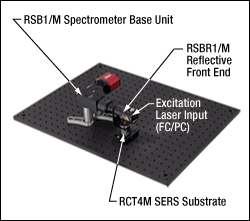 Click for Details
Click for DetailsFigure 1.3 These SERS substrates can be used with the RSB1(/M) spectrometer. Here, the RCT4M substrate is shown mounted on the RSBR1/M reflective front end sample stage with the active side facing up.
Thorlabs recommends using gloves and tweezers when handling these SERS substrates. To avoid damaging the plasmonic nanostructures, the active gold-coated surface of the substrates should not be touched directly. If needed, we recommend removing dust from the surface using clean, dry compressed air, as detailed in the Blowing Off the Surface of an Optic section in our Optics Handling and Care Tutorial.
The SERS substrates are packaged inside a vacuum sealed bag. For best performance, it is recommended to use the SERS substrates within 6 months when outside of vacuum.
For further details, please see the Sample Prep and Measurement tab.
Mounting
To avoid damaging the plasmonic nanostructures and contaminating instrumentation, ensure the active surface of the SERS substrates does not make direct contact with the mounting surface. When using with our Modular Raman Spectroscopy Kit equipped with the reflective front end, place a substrate on the sample stage with the active side facing up (see Figure 1.3). The laser beam can then be aligned to the center of the substrate. When mounting a substrate to our Portable Raman Spectrometer, it is important to make sure the active surface does not come in direct contact with the sample window. The RCT4M SERS substrate is compatible with the CDH45 adapter for square optics. For more information on the recommended mounting procedure or to discuss mounting options with the RASP spectrometer, please contact Tech Support.
*Sensitivity is dependent on the experimental conditions, including the analyte, incident laser power, and integration time.
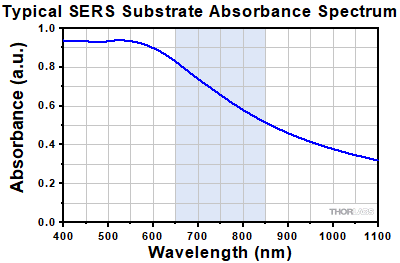 Click to Enlarge
Click to EnlargeClick Here for Raw Data
Absorbance spectrum of a typical SERS Substrate. The substrate is optimized for use with 785 nm excitation; however, the broadband absorbance enables its use with other excitation wavelengths (depicted by the blue highlighted region).
 Click to Enlarge
Click to EnlargeThis graph shows the effects of SERS on the Raman signal of 1 mM 1,2-di(4-pyridyl)ethylene. All samples were prepared using the same immersion method. Data was collected using the RSB1 Raman kit with 785 nm laser excitation and a 5 second integration time. The laser spot size was 1.5 mm2 and the power was set to 10 mW.
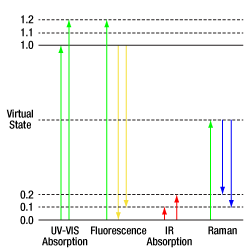
Click to Enlarge
Figure 3.1 Energy Levels of Various Radiation Types
Raman Spectroscopy
Raman Spectroscopy is a well-established technique for the characterization of chemical substances in solid, powder, liquid, or gas forms. It is based on the detection and analysis of Raman scattered light emitted from a sample upon exposure to monochromatic light.
Raman Scattering
Atoms in a molecule are held together by chemical bonds. Depending on the number of atoms and the geometry of the bonds, there are different ways molecules can vibrate. Each unique mode of vibration can be excited only with a certain, well defined amount of energy. When an exciting photon is absorbed by the molecule, it may excite a vibrational mode or absorb energy from an existing vibrational mode before being re-emitted. The loss or gain of energy due to this interaction with a vibrational mode means the photon is inelastically scattered, and this interaction between the light and the material is called the Raman effect. The resulting shift in energy and wavelength of the scattered photon due to this inelastic scattering (Raman scattering) is called the Raman shift. Raman spectroscopy measures this Raman shift.
Raman scattering is a rather rare event and occurs for only about 1 in 1 million exciting photons. It is, therefore, critical to excite the sample with a high-power light source and to collect as much Raman-scattered light as possible for analysis. To generate sufficient Raman scattering, the sample is typically exposed to high-intensity monochromatic laser light.
Because excitation of a whole set of vibrational states of a sample with a defined amount of energy (the exciting laser light) results in material-specific Raman scattering, a measured Raman spectrum may be considered a chemical fingerprint of the substance. The vibrations detected by Raman spectroscopy may differ from those modulating the molecular dipoles, which are observable by IR spectroscopy, and make it a valuable source for material analysis and complementary to other types of vibrational spectroscopy.
Energy Shift Due to Inelastic Scattering
Raman spectroscopy analyzes the shift in energy due to inelastic scattering caused by the Raman effect. The wavelength of the inelastically scattered photon is related to the excitation wavelength through energy Equation 1 describing the Raman scattering event:

where Evib is the vibrational energy of the molecule affected by the exciting photon, Eout is the energy of the scattered photon, and Ein is the energy of the exciting photon.
The photon's energy and frequency are related via the Planck-Einstein relation:

with h = 6.6260715 x 10-34 J⋅s, fin is the incoming photon frequency in Hertz. The analogous relation holds for the scattered photon (Eout = hfout).
Using Equations 1 and 2, as well as λ = c/f where c is the speed of light, the Raman shift of a molecular vibration can be characterized with knowledge of the precise wavelength of the excitation wavelength λin based on Equation 3:

Describing Raman scattering in wavelength space is a disadvantage, as it depends on the precise excitation wavelength. However, it is fixed in the Raman-shift scale, or wavenumber scale, in units of cm-1. Therefore, in order to compare Raman spectra of a substance between different experimental setups, Raman spectra are represented as 2D plots of measured relative intensity (Y-axis) versus Raman shift of the inelastic scattered light in wavenumbers (cm-1, X-axis). This unit is, in contrast to nanometers, a scale proportional to energy.
Experimental Design
Surface Enhanced Raman Spectroscopy (SERS) has widely varying applications and modalities. Because of this, SERS measurements include many variables such as excitation wavelength, power level, integration time, focal spot size, mapping, and more. Trying to measure a small signal with such a large number of variables can be challenging. This tab outlines some common issues with SERS measurements and some simple solutions to try to overcome them.
The most common issues in SERS measurements deal with either sample preparation or measurement and are summarized in Table 4.1. Each issue is also briefly explained below the table.
For further information on using SERS for commercial applications, please see the Webinar tab.
| Table 4.1 Common Issues in SERS Measurements | |||
|---|---|---|---|
| Issue | Potential Cause(s) | Possible Solution | |
| Sample Preparation | Poor Signal | Sample Molecules Bond Poorly to Gold | Use a functionalization layer to increase bonding to the gold surface. (Figure 4.1) |
| Poor Signal and Residue Observed in the Signal | Sample Too Thick, or Concentration Too High | Dilute the sample or apply in a thinner layer. (Figure 4.2) | |
| Strong Non-Raman Peaks in the Signal | Contamination | The solvent or functionalization layer may attract contamination which can interfere with the measurement (Figure 4.3). Try a different solvent or clean substrate surface with O2 plasma to limit contamination. | |
| Measurement | Poor or No Signal | Excitation Beam not Optimal Wavelength | The substrates are designed to work at 785 nm. Measurement may not be successful at other wavlengths. (Figure 4.4) |
| Focal Spot Too Small | A uniform, large area excitation beam works best. (Figure 4.5) | ||
| Large Background/Noise Signal | |||
| Fluorescence from the Substrate | Background subtraction can remove this in post-processing. | ||
| Fluorescence from Object Behind the Sample | The substrate is semi-transparent so objects behind the substrate (e.g. a plastic holder) may also cause additional peaks in the spectrum. Take care to ensure any background object does not create any unwanted peaks. | ||
Sample Preparation
Thorlabs tests each batch of substrate using BPE molecules (a standard Raman analyte) to ensure that the substrates are consistent and meet our specifications. However, some analytes may have different Enhancement Factor (EF) values based on how likely the specific molecules are to bind to the gold surface. For example, thiol-based chemistries bind preferentially to gold surfaces and will easily and strongly bind to the surface of the substrate. This allows for close proximity to the enhancement region which leads to increased signal strength. If an analyte does not bond well with gold, a functionalization layer may be necessary. A good functionalization layer will bind to the Au on one end and to the biomarker on the other end as illustrated in Figure 4.1. Determining if a functionalization layer is necessary is the first consideration when preparing a sample for experiment.
Sample thickness and concentration can also impact the quality of a SERS measurement. Since SERS is a surface-based enhancement, molecules that are too far away from the surface (>50 nm), may not experience the field enhancement. If a residue is observed on the surface while analyte is applied to the substrate, this may indicate that the analyte is too thick or too highly concentrated. Figure 4.2 shows how an overly thick or concentrated sample can obscure the signal of interest.
Another factor for sample prep is the solvent used to disperse the analyte onto the substrate. Some solvents such as dimethyl sulfoxide (DMSO), are known to absorb contamination from the air. In addition to blocking excitation or emission light, contamination molecules can block the space in the substrate valleys where most of the field enhancement is created leading to a reduction in signal. Depending on the contaminant, there may also be strong non-Raman peaks that can obscure the signal of interest. Care must be taken to ensure the solvents used will not affect the final spectrum. If a linker molecule is used to functionalize the surface, ensure that the linker molecule does not bond with unwanted contamination molecules, as illustrated in Figure 4.3.
 Click for Details
Click for DetailsFigure 4.1 Different molecules have varying affinities for bonding to gold. In cases where a molecule does not bond well with gold, a functionalization layer may be needed.*
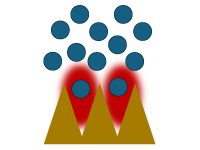 Click for Details
Click for DetailsFigure 4.2 A sample layer that is too thick may lead to a residue in the signal.*
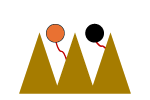 Click for Details
Click for DetailsFigure 4.3 If solvent or linker molecules attract contamination, a background signal may be present.*
Measurement
Thorlabs substrates are developed and tested on our RASP and RSB series spectrometers, which are specifically designed for Raman Spectroscopy. Several experimental factors can affect the results of a SERS measurement. One consideration is excitation wavelength. Thorlabs' SERS substrates are designed to work with 785 nm excitation. Signals may be reduced at other excitation wavelengths causing the measurement to fail. Some customers have reported success at excitation wavelengths of 632 nm and 660 nm using our SERS substrates, but Thorlabs cannot guarantee measurements at wavelengths other than 785 nm. Figure 4.4 shows the simulated electric field Enhancement Factor as a function of wavelength. This plot provides a reasonable estimate of what enhancement to expect at a given excitation wavelength.
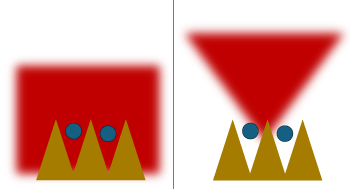 Click for Details
Click for DetailsFigure 4.5 Left: A uniform, low power density illumination allows for a larger excitation area resulting in better signal strength. Right: A high power density from a highly focused beam limits the excitation area and may lead to reduced signal strength and possible damage to the sample surface.*
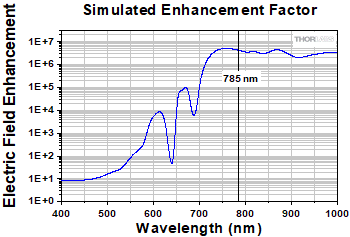 Click for Details
Click for DetailsFigure 4.4 This plot shows the simulated enhancement factor for our SERS substrates. Although there is enhancement over a broad range of wavelengths, our substrates are designed for use at 785 nm.
Laser power density also needs to be taken into consideration for successful SERS measurements. The RASP and RSB series spectrometers we employ for measurement have a defocused excitation beam of ~1.5 mm2. The samples are excited with up to 300 mW of power at this spot size, which leads to a power density on the order of 10’s-100’s W/cm2. This relatively low but uniform power density results in improved signal strength and does not pose a risk for sample damage compared to many Raman microscopes and spectrometers with highly focused beams (see Figure 4.5). Even at low power levels, the power density of a highly focused beam spot can lead to power densities of ~104 W/cm2 and may damage the samples. If such a setup is being used, we recommend using the lowest available laser power and lowest magnification objective.
Lastly, awareness of the presence of background signals is important when running an experiment. While 785 nm excitation is known to produce less substrate fluorescence in a spectrum, it will not be eliminated completely. For extremely low concentration measurements or measurements that may require higher dynamic range, this background fluorescence may obscure the signal of interest. The presence of background fluorescence can be largely eliminated in post-processing by subtracting a spectrum of the substrate with no sample present. Additionally, the substrate is semi-transparent so objects behind the substrate (e.g. a plastic holder) may also cause additional peaks in the spectrum. If an unknown peak is present in the spectrum, confirm that it is not originating from an object behind the substrate.
If you are having difficulty or have questions about your sample preparation and measurement results, please contact Tech Support. If possible, please include in your inquiry: the type of molecules you are looking to sense, your Raman system information, and any spectra already taken.
*Note these diagrams are not to scale and are only meant for illustration purposes.
2024 Advancements in Surface Enhanced Raman Spectroscopy (SERS) for Commercial Applications
Video 5.1 This webinar gives an overview of SERS for Commercial Applications.
Video 5.1 is a talk given by Matthew Singer, Physical Optics Engineer at Thorlabs, in which he discusses the potential of Surface Enhanced Raman Spectroscopy (SERS) and explores its diverse applications, from cancer diagnostics to art conservation. This talk provides valuable insights into Thorlabs' textured AR optics technology, how they can help open up new possibilities in research and applications, and how nanoscale metallic structures can enhance Raman measurements through an introduction to plasmonics.
Video Timestamps
- 04:19 - What is Raman Spectroscopy?
- 08:45 - Anti-Reflection Coatings and Textured AR
- 12:25 - Plasmonics Introduction
- 16:43 - Textured SERS
- 21:43 - Characterization of Textured SERS
- 29:25 - Applications
- 34:24 - Participant Questions
For further details please see the following publication:
M. Singer, R Priore, L. Ye, and E Baigar, "Methods for characterization of wafer scale SERS substrates," Proc. SPIE 13337, Plasmonics in Biology and Medicine XXII, 1333703 (2025)
| Posted Comments: | |
Franziska Curdt
(posted 2025-08-14 11:36:53.66) Dear Thorlabs-Team,
unfortunately we found a lot of Raman background signal on the substrate which made it useless for us. We were expecting to enhance signal of small biological samples. With the strong background of the bare SERS substrate before any exposure to our sample it was impossible to find the signal of interest. bmandal
(posted 2025-11-03 09:31:53.0) Thank you for contacting Thorlabs. We have reached out to you directly via email to discuss solutions for your specific application. |

| Key Specifications | ||
|---|---|---|
| RCT4M | RCT10M | |
| SERS Active Material | Gold | |
| Active Area |
4.3 mm x 4.3 mm | 9.5 mm x 9.5 mm |
| Laser Wavelength (Recommended) | 785 nm | |
| Minimum Power Densitya (Recommended) |
0.1 W/cm2 | |
| Lifetimeb (Recommended) | <6 Months | |
| Physical Dimensions (L x W) |
4.5 mm x 4.5 mm (0.18" x 0.18") |
10.0 mm x 10.0 mm (0.39" x 0.39") |
| Substrate Thickness | 0.500 mm (0.0197") | |
- Gold-Coated Textured Fused Quartz Substrates
- Optimized for 785 nm Laser Excitation
- Compatible with Thorlabs' Modular Raman Spectroscopy Kit and Portable Raman Spectrometer
- Square Substrates with 4.5 mm or 10.0 mm Edge Lengths and >90% Active Area
- Available in 5 Packs
The RCT4M and RCT10M Surface-Enhanced Raman Spectroscopy Substrates are designed for use in SERS to enhance Raman scattered signal by orders of magnitude. The gold-coated textured quartz substrates enable sensitivity down to parts per billion,* allowing for the measurement of low sample concentrations with significantly lower laser powers in comparison to standard Raman spectroscopy. More than 90% of each chip's top surface is SERS active.
These SERS substrates are optimized for 785 nm laser excitation and are compatible with Thorlabs' Modular Raman Spectroscopy Kit and Portable Raman Spectrometer. Aqueous samples can be placed directly on the top gold-coated side of a substrate. When mounting to a Raman system, the excitation laser should be incident on this surface. The RCT4M SERS substrate is compatible with the CDH45 adapter for square optics. Please note that the SERS substrates are single-use and washing is not recommended.
The SERS substrates are packaged inside a vacuum sealed bag. For best performance, it is recommended to use the substrates within 6 months when outside of vacuum.
*Sensitivity is dependent on the experimental conditions, including the analyte, incident laser power, and integration time.
 Products Home
Products Home









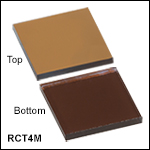
 Zoom
Zoom Surface-Enhanced Raman Spectroscopy Substrates
Surface-Enhanced Raman Spectroscopy Substrates